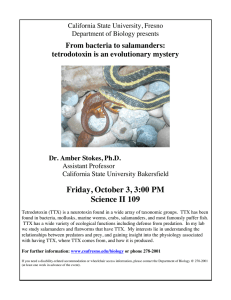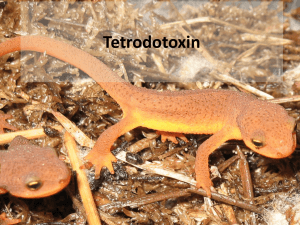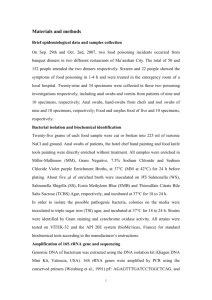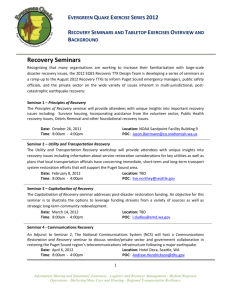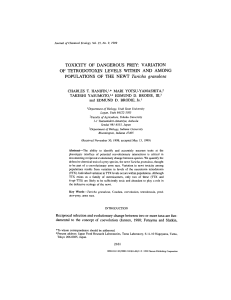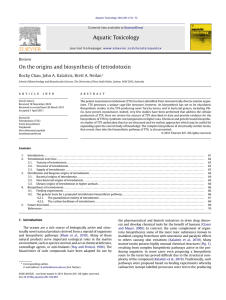suppliers predator-prey The in
advertisement
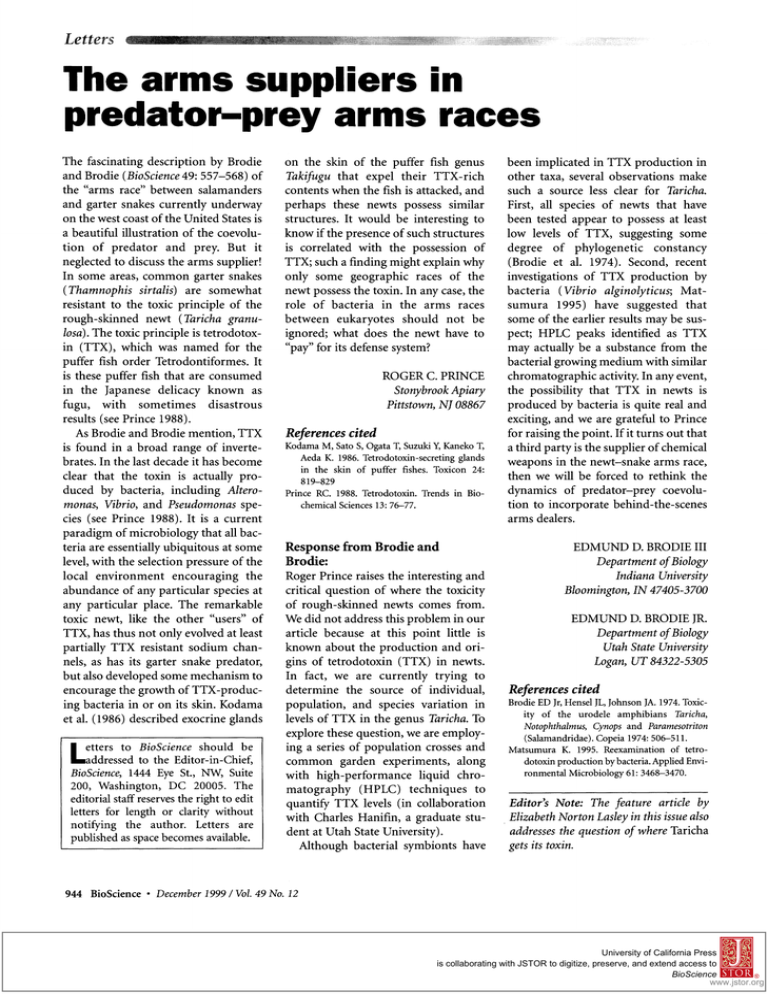
Letters The suppliers in arms races predator-prey arms The fascinatingdescription by Brodie and Brodie (BioScience49: 557-568) of the "arms race"between salamanders and garter snakes currently underway on the west coast of the United Statesis a beautiful illustrationof the coevolution of predator and prey. But it neglected to discuss the arms supplier! In some areas, common garter snakes (Thamnophis sirtalis) are somewhat resistant to the toxic principle of the rough-skinned newt (Taricha granulosa).The toxic principleis tetrodotoxin (TTX), which was named for the puffer fish order Tetrodontiformes.It is these puffer fish that are consumed in the Japanese delicacy known as fugu, with sometimes disastrous results (see Prince 1988). As Brodieand Brodiemention, TTX is found in a broad range of invertebrates.In the last decade it has become clear that the toxin is actually produced by bacteria, including Alteromonas, Vibrio,and Pseudomonasspecies (see Prince 1988). It is a current paradigmof microbiologythat all bacteria are essentiallyubiquitous at some level, with the selection pressureof the local environment encouraging the abundanceof any particularspecies at any particular place. The remarkable toxic newt, like the other "users"of TTX, has thus not only evolved at least partially TTX resistant sodium channels, as has its garter snake predator, but also developedsome mechanismto encouragethe growth of TTX-producing bacteriain or on its skin. Kodama et al. (1986) describedexocrine glands to BioScience should be Letters addressedto the Editor-in-Chief, BioScience,1444 Eye St., NW, Suite 200, Washington, DC 20005. The editorialstaffreservesthe rightto edit letters for length or claritywithout notifying the author. Letters are publishedas spacebecomesavailable. on the skin of the puffer fish genus Takifugu that expel their TTX-rich contents when the fish is attacked,and perhaps these newts possess similar structures. It would be interesting to know if the presenceof such structures is correlated with the possession of TTX;such a finding might explainwhy only some geographic races of the newt possess the toxin. In any case, the role of bacteria in the arms races between eukaryotes should not be ignored; what does the newt have to "pay"for its defense system? been implicated in TTX production in other taxa, several observations make such a source less clear for Taricha. First, all species of newts that have been tested appear to possess at least low levels of TTX, suggesting some degree of phylogenetic constancy (Brodie et al. 1974). Second, recent investigations of TTX production by bacteria (Vibrio alginolyticus; Matsumura 1995) have suggested that some of the earlierresults may be suspect; HPLC peaks identified as TTX may actually be a substance from the bacterialgrowingmedium with similar ROGERC. PRINCE chromatographicactivity.In any event, Stonybrook Apiary the possibility that TTX in newts is Pittstown,NJ 08867 produced by bacteria is quite real and exciting, and we are gratefulto Prince for raisingthe point. If it turns out that cited References Kodama M,SatoS,OgataT,Suzuki Y,Kaneko T, a third partyis the supplierof chemical AedaK.1986.Tetrodotoxin-secreting glands weapons in the newt-snake arms race, in the skinof pufferfishes.Toxicon24: then we will be forced to rethink the 819-829 PrinceRC.1988.Tetrodotoxin. Trends in Bio- dynamics of predator-prey coevolution to incorporatebehind-the-scenes chemicalSciences13:76-77. arms dealers. Response from Brodie and Brodie: Roger Prince raisesthe interestingand critical question of where the toxicity of rough-skinned newts comes from. We did not addressthis problemin our article because at this point little is known about the production and origins of tetrodotoxin (TTX) in newts. In fact, we are currently trying to determine the source of individual, population, and species variation in levels of TTX in the genus Taricha.To explore these question, we are employing a series of population crosses and common garden experiments, along with high-performance liquid chromatography (HPLC) techniques to quantify TTX levels (in collaboration with Charles Hanifin, a graduate student at Utah StateUniversity). Although bacterial symbionts have EDMUND D. BRODIEIII Departmentof Biology Indiana University Bloomington,IN 47405-3700 EDMUND D. BRODIEJR. Departmentof Biology UtahState University Logan,UT 84322-5305 Referencescited BrodieED Jr,Hensel JL,JohnsonJA.1974.Toxicity of the urodele amphibians Taricha, Notophthalmus,Cynops and Paramesotriton (Salamandridae).Copeia 1974:506-511. Matsumura K. 1995. Reexamination of tetrodotoxin productionby bacteria.AppliedEnvironmentalMicrobiology61: 3468-3470. Editor's Note: The feature article by ElizabethNortonLasleyin thisissuealso addressesthe questionof whereTaricha gets its toxin. 944 BioScience * December 1999 / Vol. 49 No. 12 University of California Press is collaborating with JSTOR to digitize, preserve, and extend access to BioScience ® www.jstor.org
